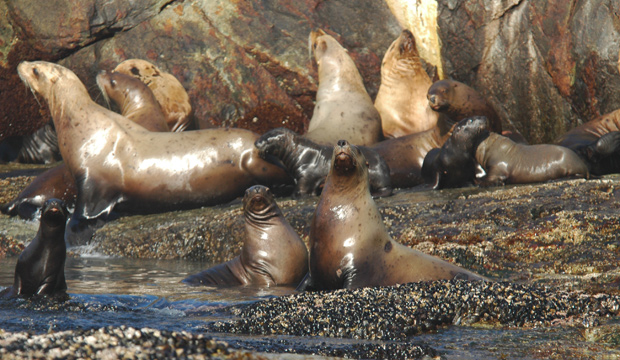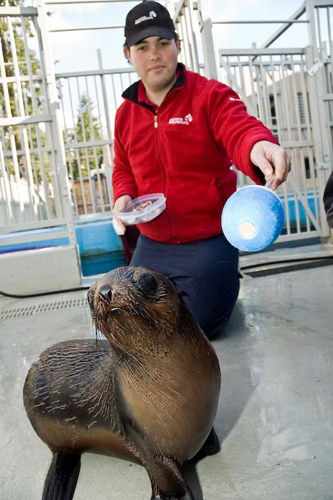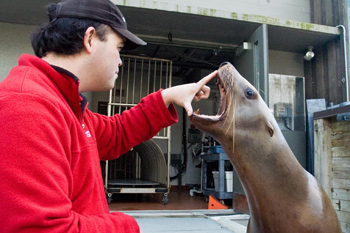
At the heart of unraveling the precipitous decline of Western Alaska’s Steller sea lions are two key questions: What do they eat? And how much do they need to survive? But determining the diet of an animal that forages in the murky depths of the North Pacific Ocean is no easy feat.
Through a process of analyzing scat (feces) collected from on-shore mating and resting areas, scientists can determine a sea lion’s most recent meals but they cannot describe long-term dietary trends. Recently, new techniques have been developed that may help scientists look farther into a sea lion’s dietary history. In a paper published in the journal Marine Ecology Progress Series, Drs. David Rosen and Dominic Tollit (University of British Columbia) evaluated the usefulness of one method as it relates to Steller sea lions and northern fur seals.
“We focused our study on Quantitative Fatty Acid Signature Analysis, or QFASA, which was developed by Dr. Sara Iverson at Dalhousie University. It is a way of looking at the unique chemical makeup of a predator, and then backcasting the kind of prey it has eaten and how much,” says Dr. Rosen. “It’s based on the idea that ‘you are what you eat’—sort of.”
Calibration Coefficients Needed to Account for Real-World Physiology
“When a sea lion eats a fish, it absorbs some of the fish’s fatty acids into its blubber layer,” Rosen explains. “At the molecular level, this process creates a unique chemical signature in the sea lion’s blubber that is partly made up of the biochemistry of the different types of fish it eats. If the diet changes over the long term, the signature changes, too.” For Rosen and Tollit, this type of information about long-term dietary trends could provide valuable insights into the role of different diets in pinniped population changes.

Collecting Steller sea lion scat
Rosen and Tollit’s study focused on a key step in the QFASA process which generates a “physiological correction factor” called the calibration coefficient. QFASA attempts to match the known chemical signatures of the prey to its predator, but the predator’s physiological processes can alter the chemical signature of the prey once it is eaten. Calibration coefficients mathematically transform the chemical signature that appears in the predator, to the one that originally appears in the fish it consumed.
“Calibration coefficients might be unique for different groups of predators, but no calibration coefficients existed for any sea lions or fur seals,” says Rosen. “So the initial goal of our study was to come up with the first set of calibration coefficients for this group of animals.”

Northern fur seal at the Vancouver Aquarium
Implications for Field Research
“Our results showed a clear difference between the phocids (harbor seals) and otariids (fur seals and sea lions) as expected for such different groups of animals. What surprised us was the significant difference in calibration coefficients between the sea lions and fur seals that both ate herring,” says Rosen. There was also a surprising difference in the apparent calibration coefficients generated when the Steller sea lions were eating different types of fish. “This was all a bit shocking,” Rosen says, “because it suggests that the calibration coefficients generated in past captive studies may not be as widely applicable as scientists had thought.”
Hence, the development of the first calibration coefficients for Steller sea lions and northern fur seals provides a sobering perspective on what scientists currently know and don’t know—and it comes with a warning against misapplying species-specific calibration coefficients in studies with other species.
“Field researchers should be judicious in applying the specific calibration coefficients for the species they are studying. They should also be conservative when drawing conclusions about the diets of sea lions and fur seals derived from QFASA,” Rosen emphasizes.

Steller sea lion at the Vancouver Aquarium
“Using the wrong calibration coefficient for a predator – even one that is closely related – can bring biases and misinterpretations about what the seals and sea lions actually eat.” He suggests that field researchers should not rely on a single technique to produce accurate results in something as complex as diet reconstruction, and a novel method such as QFASA should be used in conjunction with other analytical approaches.
Rosen believes it’s important for scientists to understand the limitations of their ability to answer key management questions—such as, what do they eat, and how much? “If you take the data past the point of the reliability of the technique itself,” he says, “you can incur some extreme consequences for the management and protection of the species.”
April 22, 2013
SEE PUBLICATION:
|

|

 |
||||||||||||
